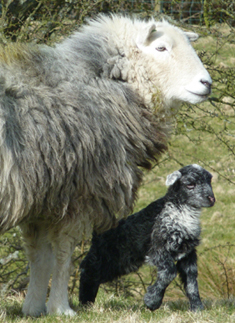Native sheep saved from extinction

This spring, Herdwick lambs are due to be born from genetic material collected a decade ago during the devastating Foot and Mouth Disease outbreak by the Sheep Trust, a national charity established at the height of the epidemic to help protect sheep breeds at threat of extinction.
For a time hope was lost… but time heals and the Heritage Gene Bank continues as a reminder of how science did and can continue to help farming and the countryside
Professor Dianna Bowles
In the Lake District, sheep farmer Andrew Nicholson, realised that the culls had the potential to wipe out the entire genetic stock of some valuable breeds, such as the Herdwick. He phoned Professor Dianna Bowles, who has her own flock of Herdwick sheep in the Yorkshire Dales, to ask if she could use her science to help save the breed.
This appeal led Professor Bowles to set up Heritage Gene Bank, the UK’s first sheep gene bank, to preserve the genetic material of native sheep breeds threatened by the disease. With the help of funding and donations, Professor Bowles began organising teams of sheep specialists and vets to collect semen and embryos from the flocks at risk of destruction.
The epidemic was at its worst in Cumbia, which suffered losses of more than one million sheep to FMD. The Herdwick breed was the first to be helped with their genetic resources saved to the bank. As the disease moved around the country, further breeds were collected, including the Rough Fells of Lancashire and the Dalesbred of Yorkshire.
 After the outbreak was over, the Sheep Trust set about getting the evidence to prove to the UK government that commercially farmed native breeds are concentrated in specific regions of the country and this constitutes a major risk in a disease outbreak, whether Foot and Mouth or Blue Tongue virus. The Trust’s study showed 12 heritage breeds were particularly vulnerable – for example, 95 per cent of all Herdwicks are found in the Lake District; similarly, 95 per cent of the South Wales Mountain breed is less than 26 kilometres from the coal fields of the Rhondda Valley, and the Romney are concentrated in Kent.
After the outbreak was over, the Sheep Trust set about getting the evidence to prove to the UK government that commercially farmed native breeds are concentrated in specific regions of the country and this constitutes a major risk in a disease outbreak, whether Foot and Mouth or Blue Tongue virus. The Trust’s study showed 12 heritage breeds were particularly vulnerable – for example, 95 per cent of all Herdwicks are found in the Lake District; similarly, 95 per cent of the South Wales Mountain breed is less than 26 kilometres from the coal fields of the Rhondda Valley, and the Romney are concentrated in Kent.
Ten years on from the epidemic, the Sheep Trust has now used a small sample from their gene bank to confirm the continuing viability of the material. Everything has gone well and Herdwick lambs will be born this spring from semen and eggs collected from sheep in 2001.
“For a time hope was lost… but time heals and the Heritage Gene Bank continues as a reminder of how science did and can continue to help farming and the countryside,” says Professor Bowles.
The Sheep Trust’s science-based evidence of regional breeds is also leading to a change in government policy. For the first time, geographical concentration has become a recognised risk factor, with the new heritage breeds becoming added to the Breeds at Risk Register.
Further information
- This story features in the March/April issue of the University of York Magazine.
